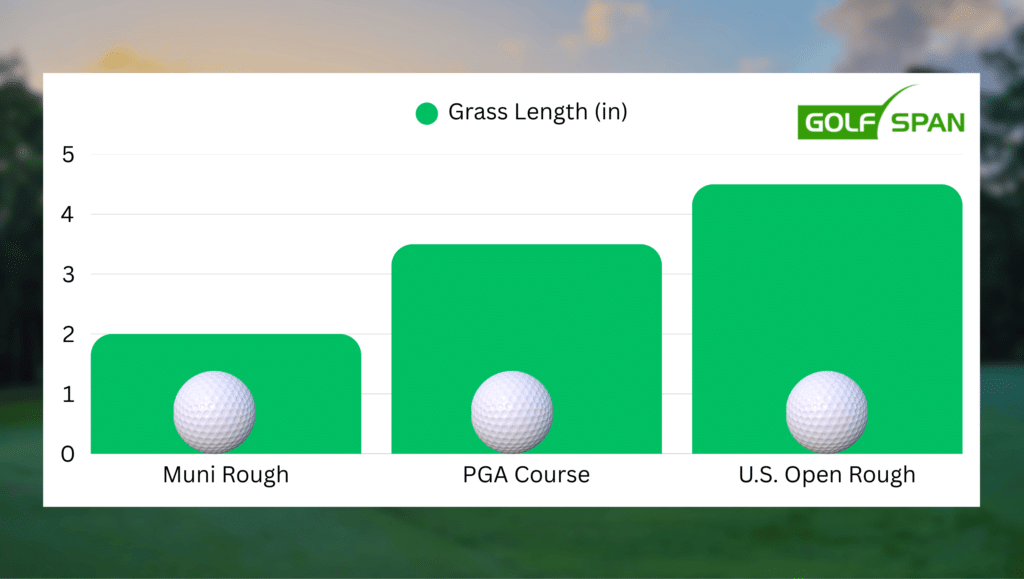If you have ever sat on your couch watching a pro miss a green or lip out a putt and thought, “I could do better than that,” it is time for a reality check. PGA Tour courses are an entirely different beast compared to your local muni, and the differences are not small. From the rough to the greens to the overall course design, everything is built to challenge the very best players in the world.
Here is a breakdown of why PGA Tour setups are so much tougher than what you are used to playing.
Let’s start with the rough. At most public courses, the rough is cut low enough to find your ball quickly and keep play moving. Even at smaller tournaments on Tour, the rough is thick, dense, and brutal. You might think of the five or six-inch rough at the U.S. Open, but even a three or four-inch cut on a PGA course is no picnic*.

To put it in perspective, a golf ball is only about 1.68 inches tall. If the rough is double or triple that height, the ball disappears. You are not just chipping out either. You are trying to advance the ball with grass grabbing your clubhead and shutting the face. Public courses, by contrast, often have a rough closer to two inches, sometimes less if it is Bermuda grass.
PGA Tour grounds crews also keep their rough healthier and more uniform. They have the staff and budget to water it properly, meaning it stays thick and strong all season. For an amateur, finding the fairway becomes crucial because missing one could cost half a shot or more every time.
And the roughs aren’t the only major difference on a pro course.
Most public courses do a pretty good job maintaining their greens. Even a budget-friendly course will usually spend a decent portion of its maintenance budget keeping greens in playable shape. But make no mistake: putting on a PGA Tour green is nothing like putting at your local club.
PGA greens are maintained to roll at speeds most amateurs never see. A typical muni might roll at 8 or 9 on the stimpmeter. A PGA Tour green is almost always 11 or 12. Some courses, like Augusta National or Oakmont, push into the 14 range. That is nearly twice as fast as what most people are used to.
Fast greens mean every mistake is magnified. If you misread the slope or mishit a putt, you are looking at three or even four putts in a hurry. The pros make it look easy, but that is because they have incredible touch and hours of practice. Your local course cannot prepare you for that level of challenge. And that’s only one reason it’s so tough to qualify for the PGA Tour.
And the pin positions are ruthless.
Even if you could putt on PGA-speed greens, you still have to deal with the pin placements. During Tour events, superintendents tuck the pins into corners of greens, right next to bunkers, or just a few paces from brutal slopes.
When you play a public version of a Tour course, the pin locations are much friendlier. If you look back at where the pins were during tournament play and try to imagine hitting to them, it becomes obvious just how precise you need to be. Now add in the fact that you will probably be hitting from much farther away, because PGA Tour players face longer approach shots than most amateurs.
PGA Tour Courses Are Longer and Built Smarter
PGA Tour setups stretch courses well past the regular yardages amateurs play. A course that is 7,000 yards for regular play can easily be stretched to 7,200 or even longer for tournament week. Tour players hit drives just under 300 yards on average, which means par fours under 450 yards are rare and par fives under 500 yards are practically nonexistent.
But it is not just length. Smart course design plays a huge role. Some of the most famous holes in golf are not long, but they are extremely difficult because of the design. Take the 17th hole at TPC Sawgrass. It is only about 150 yards, but it demands perfection. Or the 10th at Riviera, a short par four that still frustrates players with tricky angles and slopes.
PGA courses are crafted to test decision-making, ball striking, and nerves. Local courses, by necessity, have to be easier. They need to keep pace of play reasonable and cater to a wider range of players.
Another big difference is infrastructure. A PGA Tour venue is designed to handle tens of thousands of spectators. That means wide corridors for walking, space for grandstands and concessions, and layouts that allow media and TV crews to cover the action.
Most public courses simply are not built with those considerations in mind. Their goal is to get foursomes around in under five hours, not to host 50,000 fans and a TV broadcast.
Bottom line? The next time you watch a Tour pro miss a green or roll a putt six feet past the hole, remember that the conditions they are playing in are much harder than anything you have faced. Shooting 72 at your local club is a great accomplishment, but it does not mean you are ready to go toe-to-toe with the best in the world.
PGA Tour golf is a different game altogether, and that is exactly what makes it so impressive to watch.
*Note that the roughs in Florida are shorter, even for pros. Thanks USGA!
Clint is PGA-certified and was a Head Teaching Professional at one of Toronto's busiest golf academies. He was also featured on Canada's National Golf TV program, "Score Golf Canada," twice. He graduated with a degree in Golf Management from the College of the Desert in California and studied under Callaway's co-founder, Tony Manzoni. He has a handicap index of 6.2 and spends the winters near Oaxaca, Mexico, where he plays twice a month at the Club de Golf Vista Hermosa. He's written over 100 articles at GolfSpan since 2021. You can connect with Clint at LinkedIn, FB, his website, or Clintcpga@gmail.com.







